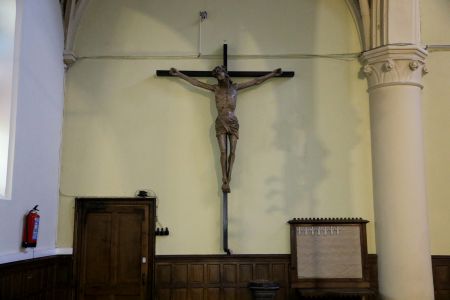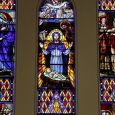Church | 1878 | Neogothic | Catholic Church


Map
Opening hours
01 January - 31 December
Mon 8.30 - 12.00
Tue 8.30 - 12.00
Wed 8.30 - 12.00
Thu 8.30 - 12.00
Fri 8.30 - 12.00
Sat 8.30 - 12.00
Sun 8.30 - 12.00
Religious offices
Description
The church of Saint-Martin was built in 1877-1878, replacing an old one that had become too small. The architect was Guillaume Müller (1833-1907) from Roeulx. He was also the architect of several other churches in the region (Saint-Nicolas in Roeulx, Saint-Martin in Trivières, Saint-Michel in Graty).
The church was restored in 1959-1960 and 2022-2023.
It is a neo-Gothic cross-shaped church built of brick and stone. It has a square tower on the south side, 30 metres high, topped by a 28-metre high spire; a triple nave of four bays, a transept and a choir with a five-sided chevet. The facing is made of bricks, with ashlars from the old church. Inside, the columns are made of hard French stone, known as Morley stone, with capitals with leafy hooks made of blue stone from Soignies and Ecaussinnes.
The church has remarkable neo-Gothic furniture: the high altar and the choir stalls, the side altars, the pulpit, two confessionals and the communion bench.
Several remarkable stained glass windows adorn the choir and the naves. Also noteworthy are the triumphal cross and the large Gothic cross from the old church, dating from the 15th century.
Other remarkable elements are the Way of the Cross, painted by Florimond Baudrenghien, and the baptismal font.
KIKIRPA : Photo-library online
Photos
Remarkable elements
Neo-Gothic choir
The choir has several elements of neo-Gothic style. The high altar was realized by the workshop of the school Saint-Luc of Ghent, according to the projects of the baron de Béthune. The altar is made of black marble with gold highlights. The tabernacle and the throne of exposition are made of carved oak, with grapes and thuriferous angels. They are surmounted by a calvary at the foot of which can be seen the coat of arms of the recipients: the de Croÿ and d'Ursel families. The polychrome statues represent the four evangelists.
There are also two oak stalls with four seats each and ten statues of saints. The walls are covered with oak panelling with sculpted panels.
Neo-Gothic furniture
The side altars are dedicated to the Virgin Mary of the Immaculate Conception and to St Martin, the patron saint of the parish. The statue of the Virgin Mary is signed, from the workshops Meyer et Cie, atelier de l'art religieux, 1877.
The oak pulpit, like the side altars, was made by the workshop of the Sint-Lukas school in Ghent. It features five high reliefs (Marriage of Mary and Joseph, Annunciation, Visitation, Flight to Egypt, Coronation of the Virgin). The pulpit was restored in 2020.
Three oak confessionals were made by Joseph Maréchal, from Ghlin, between 1884 and 1892.
The communion bench (currently in the middle of the nave), made in 1877-1887, by the workshop of the Saint Luke's School in Ghent, is made of oak. It has 12 medallions.
Stained glass windows
The church has numerous stained glass windows.
In the choir, there are five large stained glass windows dating from the 1880s. In the centre, a stained glass window with four scenes. From top to bottom: Christ on the throne, with royal attributes; Mary and Joseph; the presentation of the church by two saints (Martin and Cornelius) and two saints (Elizabeth of Hungary and Teresa of Avila); Pentecost. To the left of this window, the Sacred Heart (with the coat of arms of the Siraut family). On the right, Mary slaying the dragon (with the coat of arms of the Patoul family). This window has the same decorative motifs as the one in the right transept, representing Saint Martin.
In the left transept, a large stained glass window of the Virgin Mary, with scenes from her life, as well as the death of Saint Theresa. This window and those in the naves date from the 1930s. They have decorative motifs in the Art Nouveau style.
Above the entrance, above the organ, contemporary stained glass window (2015) by Bernard Tirtiaux.
Stations of the Cross
. Given by the parish priest Drouillon, it is by Florimond Baudrenghien (1840-1881), an artist born in Melles, the village where the parish priest was born. His self-portrait is painted in the fourteenth station (in the window) together with that of Curé Drouillon.
The first two paintings date from 1877, the others from 1878. The even-numbered paintings are signed and dated on the right, the odd-numbered on the left.
The paintings (124/86 cm) are in oak frames (233/124 cm), in the neo-gothic style.
Restored by the painter Fernand Gommaerts (1894-1975) from Mons, it was restored again in 2012 by Paul Duquesnoy from Pâturages.
Triumphal cross
Unknown origin. Oak statue, Gothic style. It dates from the end of the 15th - beginning of the 16th century. It was restored in 1960 and hung in the front of the choir in 1968. The symbols of the four evangelists are represented at the ends of the cross.
Baptismal font
From the old church. The base is made of bluestone and is in the 16th century Gothic style. The lid is a brassware item donated in 1925 by Baron Jacques Bonaert and his wife, Jeanne de Pierpont. The lid bears the coats of arms of the two families.


























